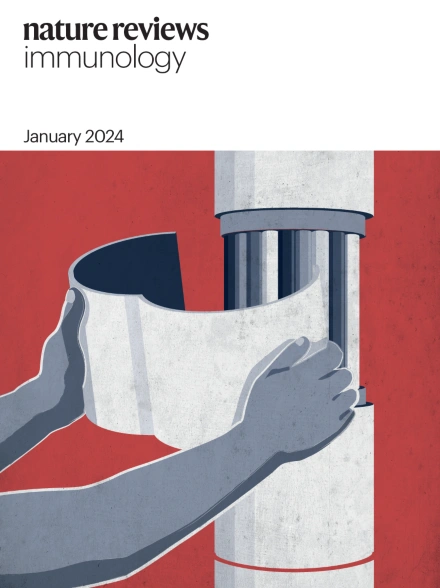Immune-mediated strategies to solving the HIV reservoir problem
IF 60.9
1区 医学
Q1 IMMUNOLOGY
引用次数: 0
Abstract
Antiretroviral therapy (ART) has markedly improved the life-expectancy of people living with HIV. However, during both HIV infection of humans and simian immunodeficiency virus infection of macaques, virus replication almost invariably rebounds upon ART interruption, due to the long-term persistency of a pool of latently infected cells harbouring integrated, replication-competent virus (known as the virus reservoir). Solving this ‘HIV reservoir problem’ is the key to achieving a cure (or at least a persistent remission) for HIV infection. Here, we summarize the key scientific evidence supporting the hypothesis that host immune responses, including those mediated by CD8+ T cells, B cells, antibodies and innate immune cells, affect the size, clonality, and cellular, tissue and organ distribution of the HIV reservoir. Importantly, we believe that any solution to the ‘reservoir problem’ must address not only the multifaceted interactions between HIV and the host immune system, but also the complex interplay between the immunobiology of memory CD4+ T helper cells (which form the main virus reservoir) and the molecular mechanisms that regulate HIV latency and reactivation. These concepts provide the rationale to develop new, immune-based approaches to ‘cure’ HIV infection; we review recent efforts to develop such therapies and their efficacy (or lack thereof) in disrupting the establishment and/or persistence of the virus reservoir in preclinical animal models and human clinical trials. HIV infection persists under antiretroviral therapy due to a reservoir of latently infected cells. This Perspective discusses how host immune responses might affect the establishment and persistence of the viral reservoir, an understanding of which supports the development of immune-based approaches to ‘cure’ HIV infection by disrupting the reservoir.


解决HIV病毒库问题的免疫介导策略
抗逆转录病毒疗法显著提高了艾滋病毒感染者的预期寿命。然而,在人类感染艾滋病毒和猴免疫缺陷病毒感染猕猴期间,病毒复制几乎无一例外地在抗逆转录病毒治疗中断后反弹,这是由于潜伏感染细胞池(称为病毒库)长期存在,其中包含整合的、具有复制能力的病毒。解决这个“HIV病毒库问题”是治愈(或至少持续缓解)HIV感染的关键。在这里,我们总结了支持宿主免疫反应(包括CD8+ T细胞、B细胞、抗体和先天免疫细胞介导的免疫反应)影响HIV库的大小、克隆性以及细胞、组织和器官分布这一假设的关键科学证据。重要的是,我们认为,任何解决“储存库问题”的方案都必须不仅解决HIV与宿主免疫系统之间的多方面相互作用,而且还必须解决记忆性CD4+ T辅助细胞(形成主要的病毒储存库)的免疫生物学与调节HIV潜伏期和再激活的分子机制之间的复杂相互作用。这些概念为开发新的基于免疫的方法来“治愈”艾滋病毒感染提供了依据;我们回顾了在临床前动物模型和人类临床试验中,最近开发此类疗法的努力及其在破坏病毒库的建立和/或持久性方面的功效(或缺乏功效)。
本文章由计算机程序翻译,如有差异,请以英文原文为准。
求助全文
约1分钟内获得全文
求助全文
来源期刊

Nature Reviews Immunology
医学-免疫学
CiteScore
93.40
自引率
0.40%
发文量
131
审稿时长
6-12 weeks
期刊介绍:
Nature Reviews Immunology is a journal that provides comprehensive coverage of all areas of immunology, including fundamental mechanisms and applied aspects. It has two international standard serial numbers (ISSN): 1474-1733 for print and 1474-1741 for online. In addition to review articles, the journal also features recent developments and new primary papers in the field, as well as reflections on influential people, papers, and events in the development of immunology. The subjects covered by Nature Reviews Immunology include allergy and asthma, autoimmunity, antigen processing and presentation, apoptosis and cell death, chemokines and chemokine receptors, cytokines and cytokine receptors, development and function of cells of the immune system, haematopoiesis, infection and immunity, immunotherapy, innate immunity, mucosal immunology and the microbiota, regulation of the immune response, signalling in the immune system, transplantation, tumour immunology and immunotherapy, and vaccine development.
 求助内容:
求助内容: 应助结果提醒方式:
应助结果提醒方式:


